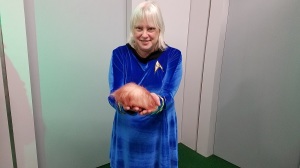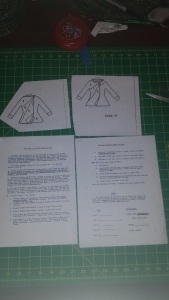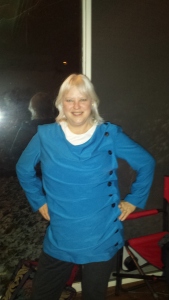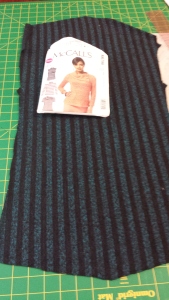When Hubby learned that a studio full of recreated sets from Star Trek:TOS was offering tours, I knew we’d be going to visit. And for that, we’d need uniforms.

A genuine Tribble from the actual set and episode
My Mini Dress
The womens dresses on TOS are one piece long sleeved mini-dresses. The outfits worn on the series feature unusual style lines. The bodice is divided into fan and wedge shaped sections, with seams forming a starburst pattern. My vintage Star Trek:TOS pattern is a simple pull over tunic. I wanted something a little more authentic.
It wasn’t hard to find PTN-018, which is an authentic replica of the starburst style mini dresses. I believe it was originally issued by Roddenberry Shop. I purchased my copy from Xscapesprops.com
But before I bought it, I checked Sewing Pattern Review. The reviews of this pattern were pretty bad. So I began searching both vintage and modern dress patterns, from the big commercial companies and small independents, looking for any dress or top with the wedge shapes pieces and starburst seaming. I could find nothing except PTN-018.
If you want the authentic starburst style womens uniform from ST:TOS, this is the only available pattern. But be warned – it’s a terrible pattern!
I was prepared for a challenge. I knew a mock up was vital. It would be foolish to skip this step with this pattern.

Wedge shaped pieces, cut on pleat
I knew I’d use stretch velvet for the actual uniform, so I chose a hippie-style print knit for my mock up. Both have nap, the velvet has the pile nap and the print has a one way design. The velvet came from Fabric Mart about a year ago. I’m not sure where the hippie print came from, I suspect maybe a Fabric Mart bundle.
This pattern is a wasteful fabric hog. If the fabric has nap, nothing can be done about that. Some of the odd shaped pattern pieces must sit on the grain at an awkward angle,
so the fabric will stretch and hang properly. If you are using a good 4 way stretch fabric with no nap and no right or wrong side, you might be able to squeeze pieces closer together to reduce waste, by flipping them upside down or setting them on the crossgrain. I couldn’t do that, and so I ended up with a big pile of scraps from both the mock up and the final uniform.
The instructions apologise for having one pattern piece printed on two separate pieces of paper, requiring you to tape the pieces together. There’s a lot more serious issues here than just taping one pattern piece together.

The Instructions
In theory, it isn’t too hard to put the pattern pieces together. Piece A is sewn to piece B, etc. But the instructions are completely unclear. The crude, hand drawn diagrams showing how the pieces fit together are essential guides.
The neck opening on the mock up turned out stupidly large. As in, 42 inches large. How do you even draft a pattern with a neck opening bigger than the hips??
I “fixed” the problem by taking deep darts along the neck. As I looked at those darts on the inside out mock up, I gradually realized I had actually added a shoulder seam to the design. The downside of this solution is that it raised the waist well above my natural waistline.
This pattern is SHORT!! Yes, I know these uniforms are VERY short on the women in ST:TOS. I made the mock up just an inch or so longer than the pattern. But, I wanted something that covered my bottom and at least part of my thigh, so I added about 6″ to the length of the skirt.
There is no Lengthen Here marking on the pattern. And 6″ is a lot to add in one spot. I picked two spots, and lengthened the skirt 3″ at each spot.
The sleeves were just a little short. I added about 2″ or so for a nice hem on the final uniform.
The instructions suggest sewing both the upper arm seam and the lower arm seam completely, then applying the rank insignia braid. It’s much easier to leave most of the under arm seam unsewn and apply the brain to the flattened sleeve. Then finish sewing the under arm seam and hem the sleeve. I used replica braid from Xscapesprops.com.

On the Bridge
To apply the braid I used clear thread in the machine and ordinary thread in the bobbin. I used an even zig zag stitch to apply the long braid strip. I used a narrow to wide to narrow zigzag stitch pattern to apply the broken braid sections.
The armhole is high and there’s little ease in the upper arm. I used a very stretchy fabric, so these fitting idiosyncrasies weren’t an issue for me.
The corner of the pleat on the skirt is supposed to be tacked to the closest starburst seam, but it actually ended up in the middle of my belly. The pleat needs to be deeper to reach the nearest seam (it might work better on someone with a flat stomach).
I was surprised the narrow collar was just one piece. It didn’t make sense. Maybe you’re supposed to cut two pieces and seam them together along the long, straight side? But the pattern piece says “Cut 1”, and the instructions don’t say anything about sewing two pieces together. All they do is suggest interfacing the collar if it’s too soft.
I made the collar about 3/4 inch deeper, and placed that long straight side on a fold. I cut the short ends and shaped long side. I applied the folded collar to the neck edge with my serger.
I omitted the zipper. My fabric is stretchy enough to pull the dress on and off.
The zipper instructions didn’t make any sense. If I were to make this costume again, in a fabric that required a zipper, I’d ignore the instructions completely and put an invisible zipper into one of the side seams.
In the end I am happy with my uniform. But it was a long struggle to get this pattern to that point. Unfortunately, I could not find any other patterns, and didn’t want to draft my own, so using this pattern as a starting point was the only solution.
The Captains Shirt

Captain and Friends
Hubby’s costume was much, much easier. The mens uniform shirts are just raglan sleeve pullovers with a slightly modified V-neck. I have several raglan sleeve pullovers in my size, but none that would fit him. Instead of messing around grading one of my patterns, I picked up Simplicity 1605 and cut a L-XL.
I used a gold stretch velvet from Spandex World, and black polyester ribbing from my stash. The pattern was simple, but I mismeasured the neck band. So, as a quick fix, I took a tuck in the neck band on each side at the shoulder seam. I have plenty of ribbing, so I plan to replace the neckband before he wears it again.
Simplicity 1605 is a nice raglan sleeve pullover and pajama pants or shorts pattern. I didn’t look at the instructions until I decided to review the pattern, because I didn’t think I could write a complete review without looking at them. They were correct, concise and clear. They explained how to sew the seams on an ordinary straight stitch machine, a zigzag stitch machine and a serger.
The pattern pieces fit together perfectly. The notches matched up and the shirt fit. This is a good pattern for beginners. The top is a great basic piece that can be made up in short or long sleeves, in one solid color or color blocked For more advanced sewists who want to play with a raglan sleeve design, this pattern is a nice starting point.










